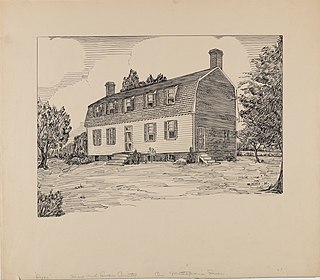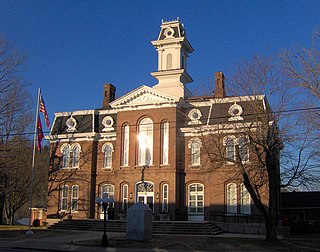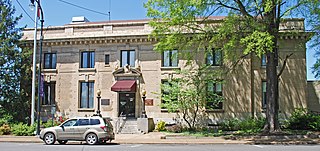
Sevierville is a city in and the county seat of Sevier County, Tennessee, United States, located in eastern Tennessee. The population was 17,889 at the 2020 United States Census.

Red Clay State Historic Park is a state park located in southern Bradley County, Tennessee, United States. The park preserves the Red Clay Council Grounds, which were the site of the last capital of the Cherokee Nation in the eastern United States from 1832 to 1838 before the enforcement of the Indian Removal Act of 1830. This act resulted in a forced migration of most of the Cherokee people to present-day Oklahoma known as the Cherokee removal. At the council grounds, the Cherokee made multiple unsuccessful pleas to the U.S. government to be allowed to remain in their ancestral homeland. The site is considered sacred to the Cherokees and includes the Blue Hole Spring, a large hydrological spring. It is also listed as an interpretive center along the Trail of Tears National Historic Trail.

Berry Hill Plantation, also known simply as Berry Hill, is a historic plantation located on the west side of South Boston in Halifax County, Virginia, United States. The main house, transformed c. 1839 into one of Virginia's finest examples of Greek Revival architecture, was designated a National Historic Landmark in 1969. The surviving portion of the plantation, which was once one of the largest in the state, is now a conference and event center.

Belmont Mansion, also known as Acklen Hall, and originally known as Belle Monte, Belle Mont or Belmont, is a historic mansion located in Nashville, Tennessee. It was built by Joseph and Adelicia Acklen to serve as the center of their 180-acre summer estate in what was then country outside the city, and featured elaborate gardens and a zoo. They lived much of the rest of the year on her plantations in Louisiana.

Rattle and Snap is a plantation estate at 1522 North Main Street in Mount Pleasant, Tennessee. The centerpiece of the estate is a mid-1840s mansion that is one of grandest expressions of the Greek Revival in Tennessee. It was designated a National Historic Landmark in 1971 for its architecture, and for its association with the Polk family, once one of eastern Tennessee's largest landowners. The house is privately owned, but may be viewed by appointment.

Prestwould is a historic house near Clarksville, Virginia. It is the most intact and best documented plantation surviving in Southside Virginia. The house was built by Sir Peyton Skipwith, 7th Baronet Skipwith, who moved his family from his Elm Hill Plantation to Prestwould in 1797. It was declared a National Historic Landmark in 2003. It is located on the north side of the Roanoke River, 1-mile (1.6 km) inland, approximately 6 miles (9.7 km) southwest of the intersection of Route 15 and Route 701, and approximately one mile north of Clarksville's town limits. Now a museum property, it is open for tours from April to October, or by appointment.

The Reynolds Homestead, also known as Rock Spring Plantation, is a slave plantation turned historical site on Homestead Lane in Critz, Virginia. First developed in 1814 by slaveowner Abram Reynolds, it was the primary home of R. J. Reynolds (1850–1918), founder of the R. J. Reynolds Tobacco Company, and the first major marketer of the cigarette. Upon liberation of the plantation in 1863, 88 people were freed from captivity and enslavement. It was later designated a National Historic Landmark in 1977. The homestead is currently an outreach facility of Virginia Tech, serving as a regional cultural center. The house is open for tours.
This is a list of the National Register of Historic Places listings in Davidson County, Tennessee.
This is a list of the National Register of Historic Places listings in Williamson County, Tennessee.

Good Spring Baptist Church and Cemetery is a historic church and cemetery mainly for the descendants within and outside of what now is called Mammoth Cave National Park and is formally located in Edmonson County, Kentucky.

Dixon, also known as Dixon's Plantation, was a privately owned historic plantation house (1793-2021) in King and Queen County, Virginia on the Mattaponi River—a tributary of the York River in one of Virginia's historic slavery-dependent tobacco-growing regions. The property was situated between the two unincorporated communities of Shacklefords and King and Queen Court House, Virginia.

Dixona is a historic house in Smith County, Tennessee, near Dixon Springs. It is one of the oldest homes in Middle Tennessee.

The Fite-Williams-Ligon House is a historic mansion in Carthage, Tennessee in the United States.

The Smith County Courthouse is a historic courthouse in Carthage, Tennessee, United States.

Belair is a historic mansion in Nashville, Tennessee. Built as a wedding present for Elizabeth Clay, a Southern belle and heiress to the Belle Meade Plantation in the 1830s, it was once the home of William Nichol, a mayor of Nashville.

Skipwith Hall, also known as Skipwith Place, Oakwood Farm, Skipwith Harlan Hill, and Oakwood Hall, is a former plantation and plantation house located in Maury County, Tennessee. It was initially built by Edward Brinley Littlefield and Cornelia Lott Skipwith as their residence.

Rattlesnake Springs is a historic site in Bradley County, Tennessee listed on the National Register of Historic Places (NRHP) in 1975.

The Bradley County Courthouse Annex, known in the past as simply the U.S. Post Office or as the Old Main Post Office, is a historic building in downtown Cleveland, Tennessee built in 1911. It was listed on the National Register of Historic Places (NRHP) in 1983.


















